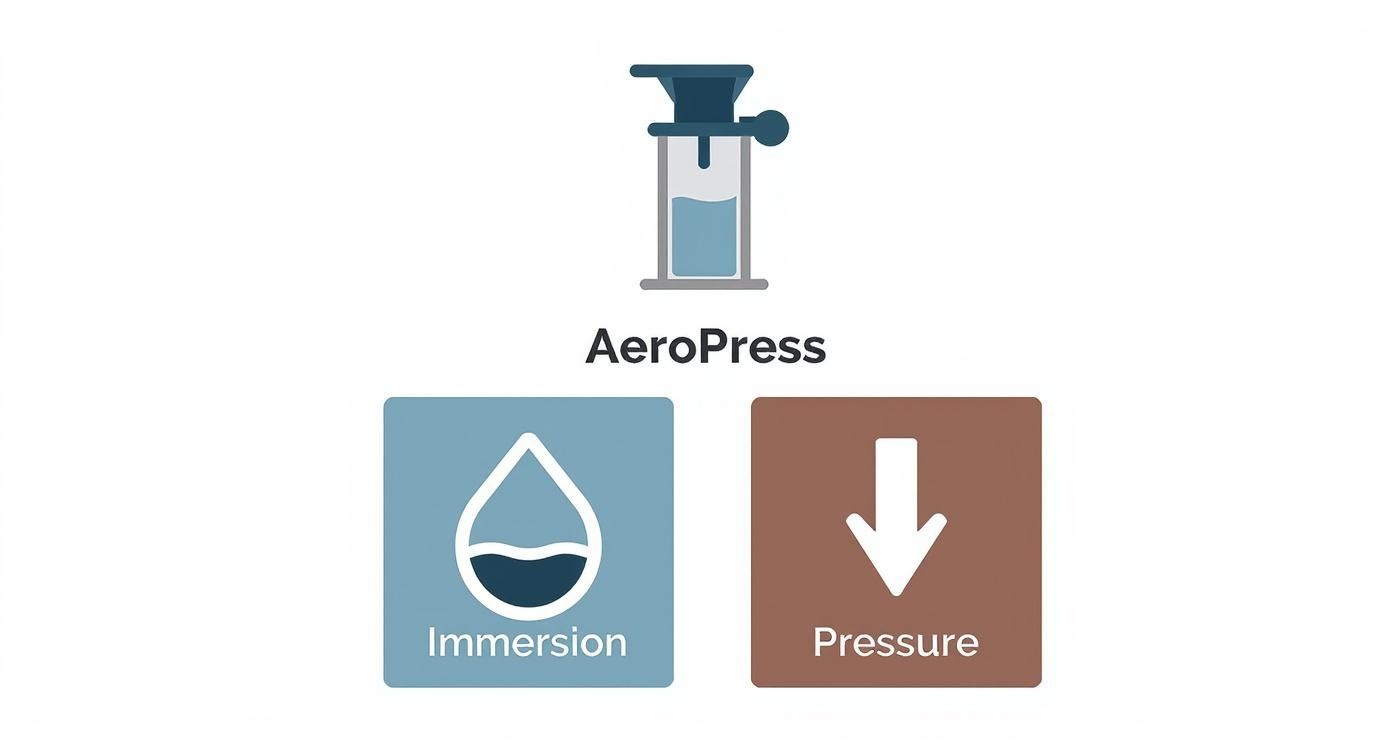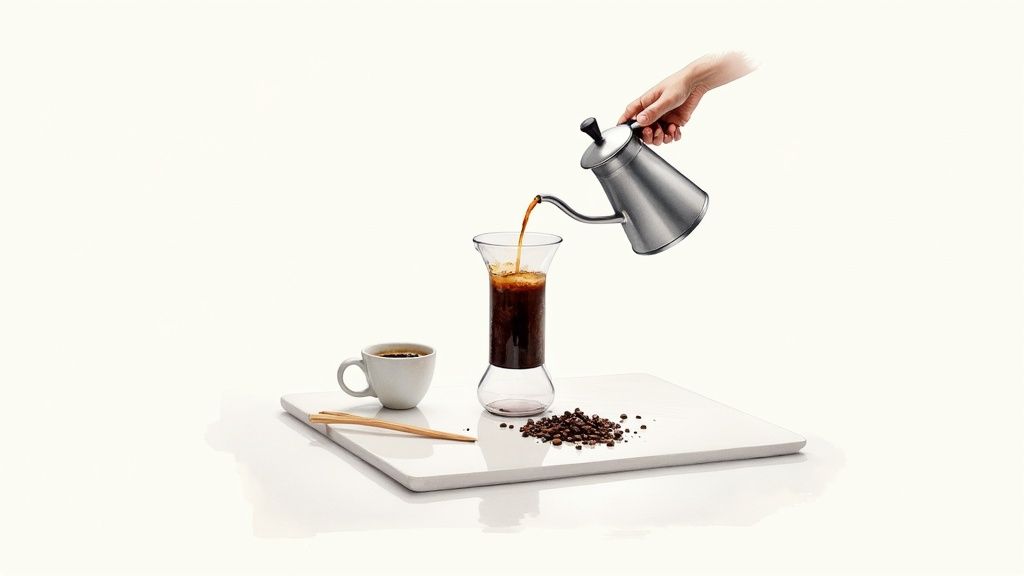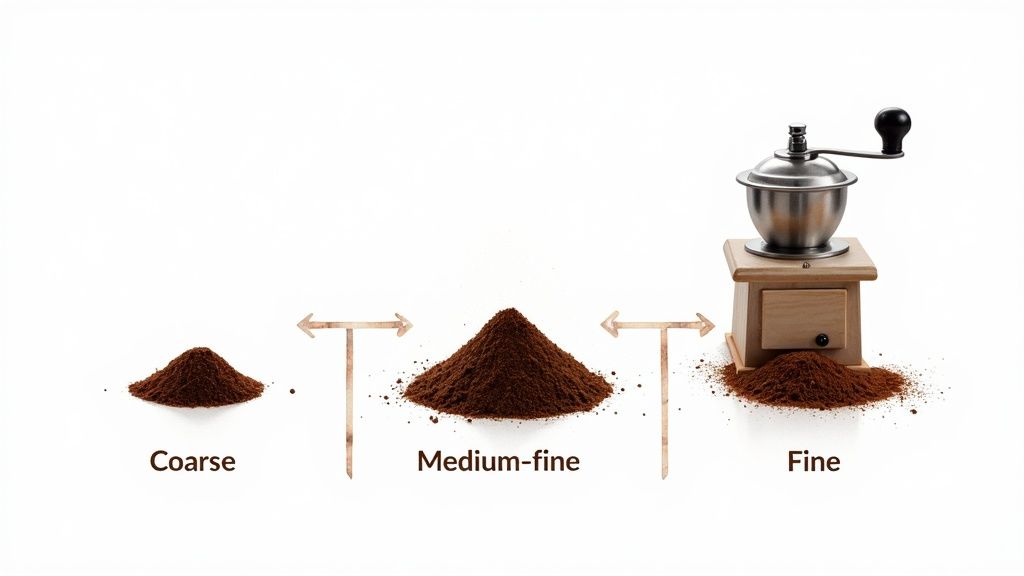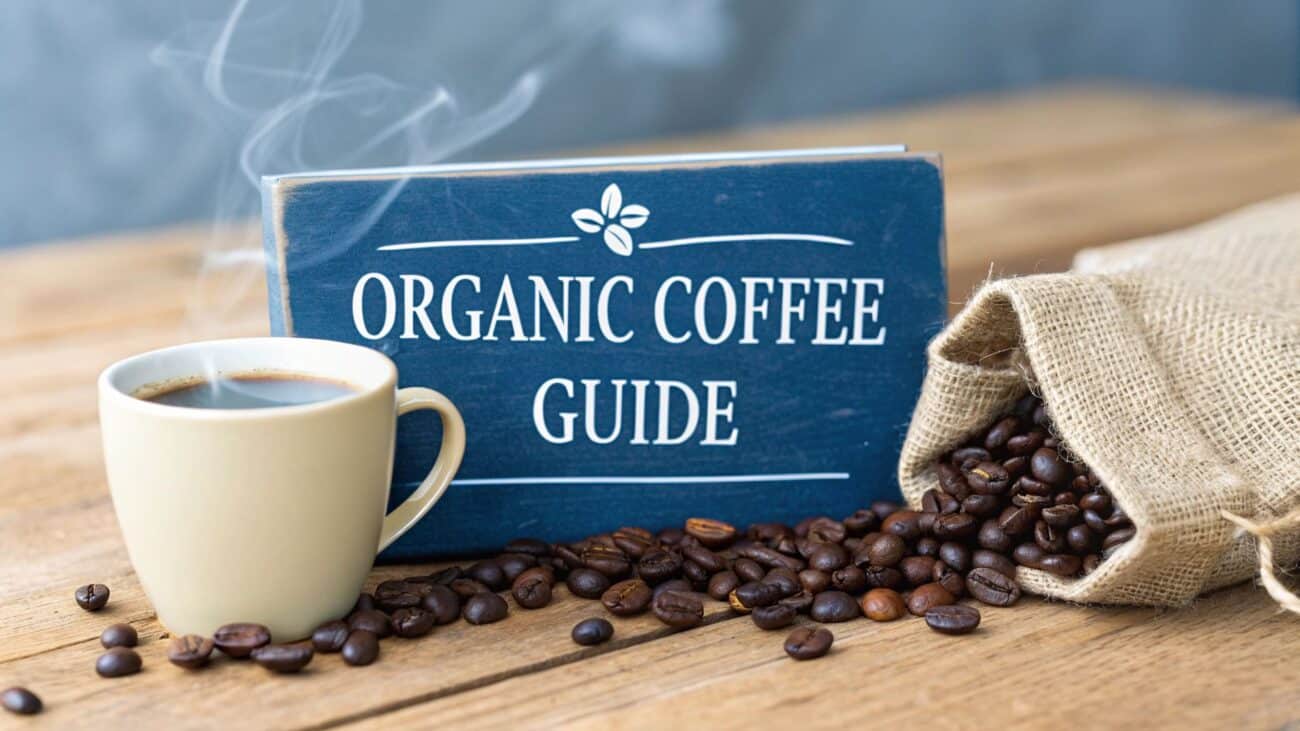Best coffee for aeropress: Guide to flavour and technique

When you’re trying to find the best coffee for an AeroPress, you’ll quickly discover it’s a matter of personal taste. That said, most coffee lovers find themselves gravitating towards light to medium roasts. These roasts are brilliant at keeping the bright, fruity, and floral notes intact—exactly the kinds of flavours the AeroPress is famous for bringing to life in a clean, vibrant cup.
Your Guide to the Perfect AeroPress Coffee
The AeroPress has a bit of a cult following, mostly because it’s so versatile. But that very versatility means that picking the right coffee is more important than ever. Think of this guide as your roadmap for navigating the world of speciality coffee to find the perfect beans for your brewer.
We're going to move past the usual vague advice and really dig into how different roast levels, bean origins, and even your grind size interact with the AeroPress's unique immersion-and-pressure system. The goal isn't just to tell you what to buy, but to show you why it works.
This way, you can confidently choose beans that line up with your tastes and turn your daily coffee ritual from just "good" into something truly exceptional. Let's demystify the whole process and unlock the full potential of your AeroPress together.
Why Your Choice of Coffee Matters
The AeroPress isn’t just another coffee maker; it’s a tool that gives you an incredible amount of control over the final flavour. It's almost like a high-fidelity speaker for your coffee beans. The right beans will play a crisp, clean, and nuanced tune, while the wrong ones can sound muddled, harsh, or just plain flat.
This level of control is a huge part of its growing popularity, especially within the UK’s booming coffee scene. In 2024, UK coffee drinkers are knocking back an estimated 98 million cups every single day. This surge lines up perfectly with a massive shift towards speciality coffee, where manual brewers that highlight bean quality are king. You can see more on these trends and their market impact over at the World Coffee Portal.
What This Guide Covers
To help you make the best choice, we’ll walk through a few key factors. We’ll explore everything from the impact of different roast levels to how a coffee’s origin shapes its entire flavour profile.
You'll also get practical advice on topics like:
- Roast Levels: How light, medium, and dark roasts behave differently in an AeroPress.
- Coffee Origins: Uncovering the signature flavours of beans from regions like Ethiopia, Colombia, and Brazil.
- Grind Size: Mastering the grind to fine-tune your extraction for a perfectly balanced brew.
- Flavour Profiles: Identifying the tasting notes you enjoy to find your ideal coffee.
By the time we’re done, you’ll be well-equipped to brew your perfect cup. And if you need a refresher on the brewing process itself, you might also find our guide on how to use an AeroPress handy.
Why Your Coffee Choice Matters for AeroPress
The AeroPress isn't just another coffee maker; it’s a brilliant little hybrid that marries full immersion brewing with a pressure-driven plunge. Think of it like a high-definition lens for your coffee beans. It has an uncanny ability to pull out all the delicate, sweet notes in a coffee, but be warned—it will just as easily amplify any harsh or bitter flavours.
This unique process means your choice of coffee is far more critical than with many other methods. The incredibly fast extraction, often done and dusted in under two minutes, leaves absolutely no room for imperfections to hide. A subpar bean will give you a subpar cup, every single time.
Getting your head around this relationship is the first step toward brewing a consistently balanced, flavourful, and deeply satisfying coffee.
The Hybrid Brewing Method Explained
Unlike a cafetière that just lets the grounds steep (immersion), or an espresso machine that relies on intense pressure, the AeroPress cleverly does both. First, the coffee grounds are fully immersed in hot water, which allows all those lovely flavours to dissolve evenly. Then, you apply gentle pressure with the plunger, forcing the brewed coffee through a paper filter.
This dual-action process is what gives AeroPress coffee its signature character.
- Immersion is where the body and depth of the flavour come from. It makes sure every single coffee ground is saturated, pulling out a rich spectrum of taste compounds.
- Pressure is what creates that clean, crisp finish. It speeds everything up and forces the liquid through a fine filter, which strips out the sediment and oils that often lead to bitterness.
The result is a cup with the richness you'd expect from immersion brewing but with the stunning clarity and low acidity of a pour-over.
By combining immersion with a pressurised plunge, the AeroPress creates a brew that is clean and bright, yet surprisingly full-bodied. This highlights the intrinsic qualities of the beans, making your selection of the best coffee for AeroPress an essential part of the process.
Why This Puts Your Beans Under a Microscope
Because the AeroPress is so incredibly efficient at extraction, it reveals the true nature of your coffee beans with startling clarity. An old, stale bean will taste flat and lifeless. No surprises there. But a fresh, high-quality bean will explode with its intended flavour profile, whether that’s the bright, zesty fruitiness of an Ethiopian single-origin or the comforting chocolate notes of a classic Brazilian blend.
The speed of the brew is also a massive factor. A typical AeroPress recipe is unbelievably quick, meaning there’s no time to mask any undesirable tastes. For instance, overly dark or oily roasts can quickly become acrid and smoky when you brew them under pressure, as their more volatile compounds are extracted almost instantly.
Ultimately, the AeroPress rewards a bit of thought when it comes to coffee selection. It empowers you to explore the subtle nuances between different beans, origins, and roast profiles. By choosing your coffee carefully, you aren't just making a drink; you're conducting a flavour experiment where every single detail matters.
How Roast Level Shapes Your AeroPress Brew
Picking the right roast is probably the biggest decision you'll make for your AeroPress. It’s the single most important factor, directly setting the bean’s foundational flavour long before it ever hits the water. Understanding how each roast plays with the AeroPress’s quick, high-pressure brew method is the key to nailing your perfect cup.
Think of it like toasting a slice of bread. A light roast is like lightly toasted bread—it still has all its original grain character. A dark roast, on the other hand, is toasted until its sugars caramelise and char, creating a totally new, bold flavour. Medium roasts? They sit happily in the middle, giving you a bit of both worlds.
The AeroPress, with its super-fast extraction, has a knack for highlighting the true, inherent qualities of a bean. This means a light roast will often give you a vibrant, acidic, and wonderfully fruity cup. A dark roast? Expect rich, bold, and chocolatey flavours to come pouring out.
Light Roasts: The Flavour Explorers
Lightly roasted beans are dense little packages, packed with the original character of wherever they were grown. When you brew them in an AeroPress, their bright, nuanced flavours are beautifully preserved. The result is often a cup that sings with acidity, floral notes, or fruity brightness.
These roasts are perfect if you love discovering the subtle tasting notes tucked away in single-origin beans. Because the AeroPress brew is so incredibly clean, it lets these delicate profiles shine through without getting muddied by sediment or over-extraction.
An AeroPress can act like a magnifying glass for light roasts, amplifying their natural sweetness and acidity. If you enjoy a coffee that tastes of jasmine, citrus, or berries, a light roast is an excellent place to start.
Medium Roasts: The Dependable All-Rounder
Medium roasts are often seen as the sweet spot for the AeroPress, and for good reason. They strike a brilliant balance between the bright acidity of a light roast and the rich body of a dark one, making them incredibly forgiving and versatile.
These beans have been roasted just long enough to develop some lovely caramelised sweetness and a fuller body, but not so long that their unique origin characteristics get lost in the heat. This creates a beautifully well-rounded cup with notes of nuts, caramel, and milk chocolate, all supported by a gentle, pleasing acidity. If you're curious about how roasters hit this mark, you can learn more in our guide to understanding coffee roasting profiles.
To get a feel for how different roasts translate in an AeroPress brew, here's a quick guide to the flavours you can generally expect.
AeroPress Roast Level Flavour Guide
| Roast Level | Common Flavour Notes | Acidity Level | Best For… |
|---|---|---|---|
| Light | Floral, fruity (citrus, berry), grassy, bright | High | Highlighting delicate single-origin notes. |
| Medium | Caramel, chocolate, nutty, balanced fruitiness | Medium | A versatile, well-rounded and forgiving daily brew. |
| Dark | Dark chocolate, smoky, roasted nuts, earthy | Low | A strong, bold, espresso-like concentrate. |
This table shows just how much control you have over your final cup, simply by choosing a different roast level.
This infographic shows how the AeroPress's core mechanics, immersion and pressure, work together to extract these distinct flavours.

The combination of full immersion followed by a pressurised plunge allows for a fast yet thorough extraction, which is absolutely ideal for getting the best out of those balanced medium roasts.
Dark Roasts: The Bold and Comforting Choice
Dark roasts are all about being bold, rich, and low in acidity. The roasting process draws the natural oils to the surface of the bean, which helps create a coffee with a heavy body and deep flavours of dark chocolate, smoke, and roasted nuts.
While some find that dark roasts can become a bit overpowering in an AeroPress, they're perfect for anyone who loves a strong, classic coffee flavour—especially if you plan on adding a splash of milk. The pressure-plunge helps create a rich, almost espresso-like concentrate that stands up beautifully.
Exploring Coffee Origins and Flavour Profiles
Right, we've nailed down how roast levels set the stage for your coffee’s character. Now let’s dig into the other major player that defines what ends up in your cup: the coffee's origin. The country, region, and even the specific farm where a coffee is grown all leave their unique fingerprint on the bean, a bit like how different vineyards produce wildly distinct wines.
The AeroPress is the perfect tool for this kind of flavour exploration. Its ability to create a clean, crisp brew is brilliant at highlighting the subtle, complex notes that make beans from one corner of the world taste completely different from another. Think of this as your passport to a world of taste.
A Journey Through Key Coffee Regions
While coffee grows all along the "Bean Belt" near the equator, a few key regions offer distinct flavour profiles that are consistently fantastic when brewed with an AeroPress. Getting to grips with these general characteristics will help you find the best coffee for AeroPress that perfectly matches what you love.
Here are a few popular origins to get you started:
-
Ethiopia: Often called the birthplace of coffee, Ethiopian beans are famous for their bright, complex, and almost tea-like qualities. An Ethiopian Yirgacheffe, for instance, might just burst with notes of jasmine, bergamot, and zesty citrus, making for a beautifully vibrant and aromatic cup.
-
Kenya: Kenyan coffees are prized for their powerful, almost wine-like acidity. Expect bold, fruity flavours like blackcurrant or grapefruit, with a rich sweetness that the AeroPress seems to capture perfectly.
-
Brazil: If you’re after a more classic, comforting coffee, then Brazil is your go-to. These beans typically offer a smooth, low-acidity profile with deep notes of chocolate, nuts, and caramel. The result is a rich and deeply satisfying brew.
-
Colombia: Known for their incredible balance, Colombian coffees are a fantastic middle-ground. They often present a pleasing mix of nutty sweetness and gentle fruit acidity, making them a versatile and dependable choice for a delicious daily brew.
The AeroPress truly excels at separating and showcasing the delicate tasting notes of single-origin coffee beans. Its quick, clean extraction stops these nuanced flavours from getting muddled, allowing you to really appreciate what makes each origin so special.
Connecting Geography to Your Palate
Thinking about coffee in terms of its origin empowers you to move beyond just picking a roast level. You can start actively seeking out specific taste experiences. Fancy a bright, zesty cup to kick-start your morning? Look for an Ethiopian or a Kenyan coffee. Craving something smooth and chocolatey for the afternoon? A Brazilian bean will most likely hit the spot.
This knowledge is particularly useful when you consider how much UK coffee lovers are investing in brewing at home. The average Brit spends around £16 monthly on coffee for their kitchen, a clear sign that quality is becoming a top priority. It's often professionals in demanding fields like journalism and healthcare who lead the nation in coffee consumption, and for them, the quick, portable nature of the AeroPress is a massive plus.
Ultimately, exploring different origins is an exciting journey. Don't be afraid to experiment with beans from various regions. By connecting geography to taste, you’ll develop a more sophisticated palate and find the confidence to discover new coffees that truly excite you.
Mastering the Grind for a Perfect Extraction
If the roast level sets your coffee's fundamental character, then the grind size is how you fine-tune the final performance. Think of it as the secret weapon in your brewing arsenal; it dictates how quickly water can get in and pull all those delicious flavours out of the grounds. Get it right, and you’re rewarded with a perfectly balanced cup.
The concept is pretty simple when you picture it. Imagine pouring water through a bucket of large stones—it’ll rush straight through. Now, pour that same water through a bucket of fine sand. It slows right down, doesn’t it? It has to work its way through, spending much more time in contact with every single particle.
Coffee grounds work in exactly the same way. A coarse grind creates big gaps for water to flow through quickly, leading to a shorter extraction time. A finer grind creates more resistance, slowing the water down and giving it more time to extract flavours. The AeroPress, with its famously quick brew cycle, is particularly sensitive to these little adjustments.
Finding the Sweet Spot: A Medium-Fine Grind
For the AeroPress, your best starting point is a medium-fine grind, which should have a texture similar to table salt. This consistency exposes just enough surface area for a quick and even extraction without creating so much resistance that the plunge becomes a workout or, worse, introduces bitterness. It’s the perfect middle-ground that works beautifully for most AeroPress recipes.
Of course, "medium-fine" is just the beginning. The real mastery comes from learning how to tweak your grind based on how your coffee actually tastes. This is the skill that turns you from someone who just follows a recipe into a brewer who can adapt and perfect their coffee every single time. For a deeper dive, our comprehensive coffee grind size guide is an excellent resource.
Your taste buds are the ultimate guide. Learning to identify the signs of under- and over-extraction, and knowing how to correct them with a simple twist of your grinder, is the most powerful skill an AeroPress user can develop.
How to Troubleshoot Your Brew by Taste
Once you start tasting your coffee with a critical palate, you can begin making tiny adjustments to your grinder to dial in that perfect flavour. This feedback loop is the key to achieving a consistently brilliant extraction.
Here’s a simple framework to get you started:
- If your coffee tastes sour, acidic, or thin: This is a classic sign of under-extraction. The water didn’t have enough time to pull out the sweet compounds needed to balance the natural acids. The solution? Grind your coffee finer for the next brew to slow things down.
- If your coffee tastes bitter, harsh, or hollow: This points to over-extraction. The water spent too much time with the grounds, pulling out unwanted bitter compounds. To fix this, grind your coffee coarser next time to let the water flow through a bit faster.
By paying attention to these simple taste cues, you can methodically adjust your grind until you hit that delicious sweet spot where the coffee is balanced, vibrant, and bursting with flavour.
Our Top Coffee Picks for Your AeroPress
Alright, now that we’ve covered the theory behind roast levels, origins, and grind size, you’re ready to pick the perfect coffee for your AeroPress. Let's put all that knowledge into practice. We’ve organised our top recommendations based on the kinds of flavours you’re probably craving. This isn't about pushing specific brands, but about pointing you towards the types of beans that genuinely sing when brewed with this versatile gadget.
Whether you’re in the mood for something vibrant and zesty or a brew that’s smooth and comforting, think of this list as your go-to shopping guide. It’s time to match your taste buds with the right bag of beans.
Bright, Fruity, and Adventurous
If you love a coffee that wakes up your palate with a lively, acidic zing, then light roast single-origin beans are your best bet. The AeroPress is a master at showcasing the delicate, complex notes in these coffees, producing a cup that’s incredibly clean, bright, and bursting with character.
For this profile, look for beans from East African countries. They're world-renowned for their exceptional acidity and vibrant flavours.
- Origin to Look For: Ethiopian Yirgacheffe or Sidamo. These beans are the undisputed superstars of bright, floral, and almost tea-like coffee.
- Roast Level: Light. A light roast is absolutely essential here to preserve those delicate aromatics and zesty acidity. Anything darker and you’ll lose what makes them special.
- Tasting Notes to Expect: Get ready for a symphony of jasmine, bergamot, lemongrass, and bright citrus fruits like lemon or orange. The brew will be exceptionally clean, allowing these nuanced flavours to really pop.
Rich, Chocolatey, and Comforting
Sometimes you just want a coffee that feels like a warm hug in a mug—something smooth, rich, and deeply satisfying. If that’s you, then you'll want to explore beans from Central and South America. These coffees are famous for their classic, approachable flavours that just hit the spot every time.
A medium roast is perfect for this profile. It develops the beans' natural sweetness and body without introducing any of those harsh, smoky notes you get from darker roasts.
- Origin to Look For: Brazil or Guatemala. Brazilian beans offer that classic nutty and chocolatey profile with low acidity, while Guatemalan coffees often add a lovely touch of sweet cocoa and toffee.
- Roast Level: Medium. This roast level is the sweet spot, unlocking notes of caramelised sugar and roasted nuts to create a full-bodied and satisfying cup.
- Tasting Notes to Expect: Think milk chocolate, roasted almonds, caramel, and a hint of brown sugar. It’s the perfect profile for a comforting daily brew.
A medium-dark roast can also work beautifully here, especially if you plan on adding milk. The AeroPress creates a strong, espresso-like concentrate that stands up brilliantly to dairy, producing a rich and creamy flat white or latte.
Balanced, Versatile, and an All-Rounder
Then there are days when you just want a coffee that does everything well. A dependable, delicious, and well-rounded cup that hits all the right notes without being too extreme. For this, a classic Colombian coffee is an unbeatable choice.
Colombian beans are celebrated for their superb balance of sweetness, gentle acidity, and smooth body. They are the ultimate crowd-pleaser and a fantastic starting point if you're just beginning to explore the world of specialty coffee beans.
- Origin to Look For: Colombian Supremo. These larger beans are known for their consistent quality and wonderfully well-rounded flavour.
- Roast Level: Medium. A perfect medium roast brings out a gentle fruitiness while developing a satisfying nutty sweetness.
- Tasting Notes to Expect: Look for a harmonious blend of caramel, citrus, and hints of red apple or cherry. It’s an incredibly versatile coffee that tastes fantastic no matter how you brew it.
Beyond our specific recommendations, you might also want to explore offerings from renowned roasters like Stumptown Coffee Roasters, who are known for their quality beans.




